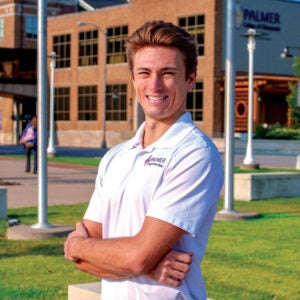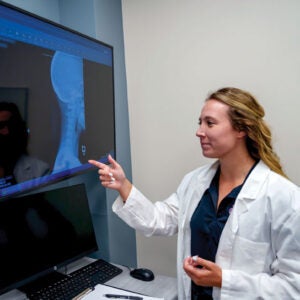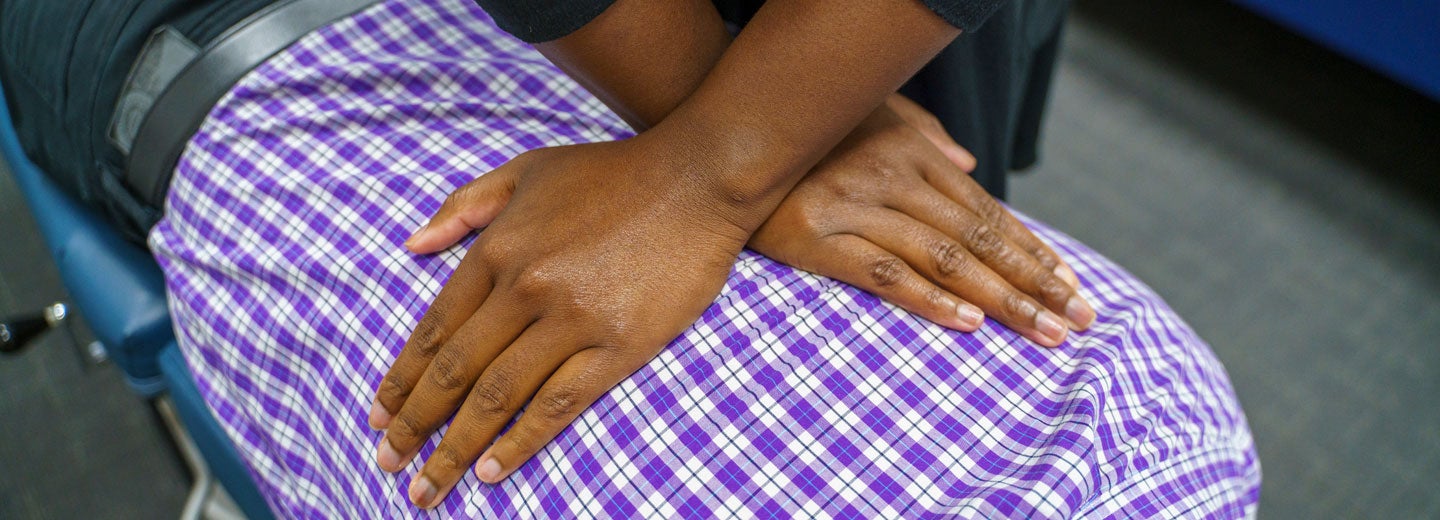As new technologies and modalities appear on the landscape of chiropractic education, Palmer College of Chiropractic students — and the profession — remain certain they’re receiving the best hands-on education available. Anywhere.
 You have to get up pretty early to catch Jacob Kwast, a Palmer College student now in his seventh trimester on the Main Campus. By 8 a.m., he is already well into his day, providing hands-on care in the Palmer Chiropractic Clinic. Fortunately, Jacob always has a few minutes to talk about training and technique.
You have to get up pretty early to catch Jacob Kwast, a Palmer College student now in his seventh trimester on the Main Campus. By 8 a.m., he is already well into his day, providing hands-on care in the Palmer Chiropractic Clinic. Fortunately, Jacob always has a few minutes to talk about training and technique.
“This is why we’re here,” says Jacob. “We all want to work with patients and push ourselves to provide the best care possible.”
For Jacob, Palmer’s dedication to hands-on training and direct patient interaction has come in stark contrast to his undergraduate experience. “My undergraduate program was interrupted by the COVID-19 pandemic,” he says. “When classes went online, it didn’t work for me. I saw my grades go down because the virtual instruction was simply not effective. I was so thankful that Palmer provided an in-person option when I arrived here.”
The difference at Palmer has been drastic.
“In-person learning is critical to a chiropractic education,” Jacob says. “You can sit at home and read through notes, but you miss so much if you’re not interacting directly with faculty and clinicians. How do you learn hands-on when you’re not hands-on? I’ve learned a lot just by asking questions of faculty and hearing about their personal experience; it’s really challenged my clinical thinking skills.”
Jacob knows a student who went to another chiropractic college and completed the first year of study remotely. “She’d been thousands of miles away,” says Jacob. “When she finally got to campus, the experience was not what she expected, and she left that program. Unless you’re here, really experiencing the work, getting to know your peers, and being pushed forward by the faculty, there’s no way of knowing what chiropractic is about.”
Since 1897, Palmer College has defined the field of chiropractic education. Along the way, the curriculum has been carefully refined to provide students like Jacob with a cutting-edge, hands-on educational and clinical experience that prepares them for their future careers.
Today, schools and colleges around the world are experimenting with online and distance education, and chiropractic colleges are no exception. Can colleges and instructors balance the benefits of online education and overcome the potential pitfalls of remote learning?
At Palmer, the answer is yes.
The Best of Both Worlds
At first glance, the benefits of online education are obvious; for students, a distance format provides flexibility and different opportunities to engage in the classroom. For colleges, online education can deliver their curriculum to more students in more places.
However, these benefits require compromises. Ask anyone who has sat through a Zoom meeting — the in-person experience is not easily (or enjoyably) replicated online. Plus, for college students, so much learning happens in person and outside the classroom. Study groups, office hours, and late-night conversations with peers are all essential to how knowledge is built and shared on a college campus.
This reality is even more evident at Palmer, where hands-on education remains at the heart of Palmer’s field-leading curriculum. When it comes to courses in technique and anatomy, there is no substitute for an in-person curriculum like the one developed by Palmer College over the last 126 years.
“COVID was a catalyst accelerating change in the already dynamic landscape of education,” says College Provost Daniel Weinert, D.C., Ph.D. (Main, ’96). “Harnessing technology represents a pivotal opportunity to provide effective and engaging remote learning experiences for our students. By embracing innovative tools and interactive platforms, Palmer empowers students to consume educational content in quantities that suit their pace, at times that suit their schedules, and in locations that suit their circumstances.
“That said, remote instruction is not ideal for all learning. We remain steadfast in providing early and frequent hands-on experiences that foster manual skills critical for Doctors of Chiropractic. Ultimately, the success of pedagogy is measured by the growth, development, and achievement of our students. Our curricular and pedagogical choices are guided by what is best for developing incredible Doctors of Chiropractic.”
This guiding principle has led to the development of a hybrid model, blending the most effective educational and technological innovations with Palmer’s grounded and proven hands-on, in-person curriculum.
“There’s a responsible way to use this new technology and integrate it into our curriculum,” says Palmer College Chancellor and CEO Dennis Marchiori, D.C., Ph.D. (Main, ’90). “We’ve done this with anatomy, for instance; we have brand new cadaver labs, but we also make use of Complete Anatomy, an augmented-reality learning platform available on every device the students use.”
At Palmer, students are combining the latest technology with long-standing methods of studying anatomy. The result of this hybrid approach is an education anchored in tradition and sharpened by the newest, proven methods of study. “Students want to know we’re using the latest tools and that they can access online resources 24/7,” says Dr. Weinert. “They come to Palmer to get the best chiropractic education in the world. That’s the goal.”
Students are already seeing the benefit of the new approach. “The tools and support at Palmer are incredible,” says Samantha Schumacher, a 10th-trimester student and student council president. “We have access to everything you could ask for in terms of technology, and then we have the best instructors in the world standing right next to us. It makes you feel so much more confident when you start interacting with patients.”
For Samantha, who will graduate soon and begin practicing in Coeur d’Alene, Idaho, the experience at Palmer paved the way for a future in chiropractic. “The amazing Palmer education and clinical work, the Palmer Package, the faculty, the network of friends and alumni I’ve developed here — it’s all played a part in creating this next step.”
“Palmer College is the most trusted and most innovative chiropractic college today,” says Dr. Marchiori. “Technology isn’t going to diminish that. It’s only going to take us further.”
Learning Beyond the Classroom
Research tells us that nearly half of what students learn in an academic program comes from student-to-student interactions. College administrators have a responsibility to foster an environment that promotes these types of interactions.
The value of in-person education extends beyond the lab and the lecture hall. “Our students see other options out there, but they are still asking to come to campus,” says Dr. Weinert. “They see the value not just of in-person lectures and labs, but the discussion groups, for example, as places where you learn from your peers. That’s where you learn the philosophy. That’s where you learn how to think about chiropractic and how to practice your voice in chiropractic.”
The dedication to enhancing the student experience is what sets Palmer apart. “So much goes into creating an enriching life for our students,” says Dr. Marchiori. “We’ve built a learning environment with the infrastructure to support student learning and the opportunities to build networks and relationships that last a lifetime.”
At Palmer, buildings are designed with state-of-the-art technology, with study rooms, and communal spaces at their center. The result is a holistic learning environment where like-minded people can support and drive each other. “There is a real sense of camaraderie here,” says Jacob. “People are dedicated to making themselves and their fellow students better. It’s one of the things that really makes Palmer stand out from other schools.”
“Extracurriculars, student council, the rugby team — those have all been a huge support system for me,” adds Samantha. “If we were completely online, it would be a huge loss. You learn so much just from talking with your peers and spending time with like-minded people.”
Palmer is committed to maintaining its rich, on-campus learning community. The College is home to nearly 100 clubs and extracurricular organizations on its three campuses. New buildings like Paul and Donna VanDuyne Hall on the Main Campus give students the opportunity to live comfortably on campus and develop social and intellectual communities. Dr. Weinert understands the benefits of hybrid education and also believes that a fully online curriculum would be a disservice to students. “The reality is you’re not going to know anybody, you will not know your instructors and you will not know your fellow students. Palmer students create lifelong bonds that contribute to making them successful chiropractors — you will not get the same outcomes in a fully remote program.”
A Tradition of Forward Thinking
 Palmer’s commitment to hands-on education is rooted in tradition, but it’s also what keeps the curriculum on the cutting edge of chiropractic training.
Palmer’s commitment to hands-on education is rooted in tradition, but it’s also what keeps the curriculum on the cutting edge of chiropractic training.
“This is a hands-on profession,” says Samantha. “It’s so important to start that work early and to do it with supportive faculty at your side answering questions and guiding you with their experience.”
Faculty are constantly working to advance the quality of Palmer’s curriculum with frequent evaluations and regular updates to the school’s clinical approach.
“Palmer is adapting its program to maintain its lead in the field,” says Jacob. “The faculty are going in the right direction and setting the ethical standard by encouraging more hands-on work earlier in the curriculum. That’s better for students and for the people we will someday care for.”
Chiropractic was born at Palmer, and the College is committed to maintaining the highest educational standards.
“Sometimes, leading the field has meant developing new strategies and implementing new technology,” says Dr. Marchiori. “At other times, leading the way has meant we stay with tradition, question trends and continue with proven practices.”
These decisions are not made lightly, he adds. Together, faculty and College administration tirelessly review the latest developments in the field, ensuring that the Palmer curriculum is serving students and their future patients as effectively as possible.
Palmer is driven by student success. Students find success because they receive the best possible training using the latest proven tools and techniques — and because they enter an engaged and supportive alumni community.
“Palmer is the best for a reason,” says Samantha. “The faculty and your fellow students challenge you, but they are also standing right beside you, supporting everything you do along the way.”

 You have to get up pretty early to catch Jacob Kwast, a Palmer College student now in his seventh trimester on the Main Campus. By 8 a.m., he is already well into his day, providing hands-on care in the Palmer Chiropractic Clinic. Fortunately, Jacob always has a few minutes to talk about training and technique.
You have to get up pretty early to catch Jacob Kwast, a Palmer College student now in his seventh trimester on the Main Campus. By 8 a.m., he is already well into his day, providing hands-on care in the Palmer Chiropractic Clinic. Fortunately, Jacob always has a few minutes to talk about training and technique. Palmer’s commitment to hands-on education is rooted in tradition, but it’s also what keeps the curriculum on the cutting edge of chiropractic training.
Palmer’s commitment to hands-on education is rooted in tradition, but it’s also what keeps the curriculum on the cutting edge of chiropractic training.